

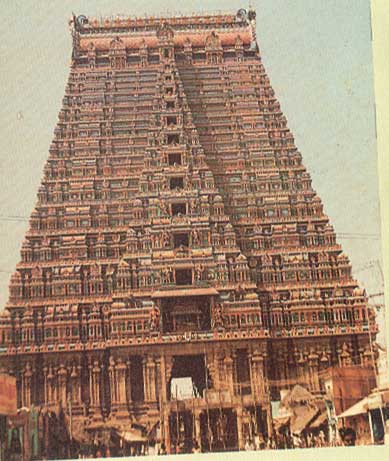



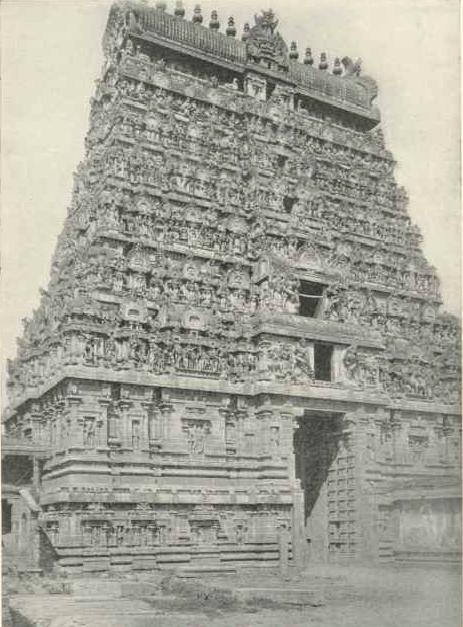





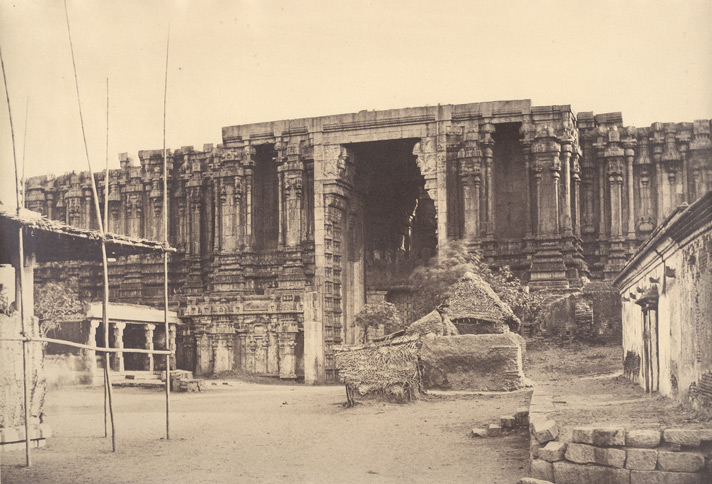






















| Srirangam | |
|---|---|
| Neighbourhood | |
 |
|
| Coordinates: 10.87°N 78.68°ECoordinates: 10.87°N 78.68°E | |
| Country | India |
| State | Tamil Nadu |
| District | Tiruchirapalli |
| Elevation | 70 m (230 ft) |
| Population (2001) | |
| • Total | 181,556 |
| Languages | |
| • Official | Tamil |
| Time zone | IST (UTC+5:30) |
| PIN | 620006 |
| Telephone code | 91-431 |
| Vehicle registration | TN-48 |
Srirangam is bounded by the Kaveri River (also known as Cauvery river) on one side, and the Kaveri distributary Kollidam (Coleroon) on the other side. Srirangam is home to a significant population of Srivaishnavites (followers of Lord Vishnu, one of the triumvirate of Hindu Gods the other two being Lord Siva, the Destroyer and Lord Brahma, the Creator).
Sri Ranganathaswamy Temple
According to the temple's website, Srirangam can be considered the biggest functioning Hindu temple in the world, as it covers an area of about 631,000 square metres (6,790,000 sq ft) with a perimeter of 4 km (10,710 ft).[1] Angkor Wat is bigger but non-functioning.
Srirangam is the foremost of the eight self-manifested shrines (Swayam Vyakta Kshetras) of Lord Vishnu. It is also considered the first, foremost and the most important of the 108 main Vishnu temples (Divyadesams). This temple is also known as Thiruvaranga Tirupati, Periyakoil, Bhoologa Vaikundam, Bhogamandabam. In the Vaishnava parlance the term "KOIL" signifies this temple only. The temple is enormous in size. The temple complex is 156 acres (0.63 km2) in extent. It has seven prakaras or enclosures. These enclosures are formed by thick and huge rampart walls which run round the sanctum. There are 21 magnificent towers in all prakaras providing a unique sight to any visitor. The temple town lies on an islet formed by the twin rivers Cauvery and Coleroon.
The Srirangam temple complex is composed of 7 concentric walled sections and 21 towers gopuram.[2] The gopuram of the temple is called the Rajagopuram and is 236 feet (72 m) tall, the tallest in Asia.
The temple has seven prakaras (elevated enclosures) with gopurams articulating the axial path, the highest at the outermost prakara and the lowest at the innermost. In historic times, just after the construction of this temple, the city of Srirangam lived completely within the walls of this temple and hence is quoted as an example of Hindu religious utopia - during its peak of existence.
The Srirangam temple is one of the three temples of the god Ranganata that are situated in the natural islands formed in the Kaveri river. They are:
- Adi Ranga: the Ranganathaswamy temple at Srirangapattana
- Madhya Ranga: the Ranganathaswamy temple at Shivanasamudra
- Antya Ranga: the Ranganathaswamy temple at Srirangam
Clothes such as Silk Sarees, Dhoti, Towels, etc.., used for religious purposes are auctioned here.
Inside the temple compound, there is a separate temple for the goddess Andal. Additionally, There is a museum, a library and a bookshop as well.
History
According to Vedas, the vimana (adornment on top of the main tower) of Srirangam temple is believed to have come out of the ocean of milk (Tamil: "paarkadal" - பாற்கடல்) with the powers of Brahma deva (One of the three main Gods of Hinduism). The incarnation of Lord Vishnu called Ramavathara has performed poojas to Vishnu's idol (deity in a reclining posture). As a symbol of love he gifted the idol to Vibishana (brother of Ravana of the Hindu epic Ramayana) to take back with him to Sri Lanka. There was a condition that he could not set the idol on earth and if he did it would set itself permanently. Vibishana took this idol and was traveling towards Sri Lanka, and came upon the banks of the river Cauvery, during when utsavam (festival) for the god had to be performed and he placed the idol on banks of river Kaveri. When the utsavam got over, the lord refused to move as he loved the place (Srirangam). When vibhishana requested him to come along with him, the lord refused but promised to bless Vibhishana by always facing South (the direction of Sri Lanka, home to Vibhishana) Hence it is that the deity (in a reclining posture) faces South. Then Chola kings Dharmavarcholan and Killivalavan developed the shrine into the big temple seen now. They built the basic foundations and main buildings.Srirangam was one of the Hindu shrine complexes that was sacked (plundered) during Ala-ud-din Khilji's deccan invasion, led by his general Malik Kafur. Services at the shrine had temporarily halted following this sack, and were resumed later.
Transport
Air
The nearest airport is Tiruchirappalli International Airport.Trichy Airport has connections to Chennai, Mumbai, Bangalore, Thiruvanathapuram, Singapore, Dubai, Sharjah, Kuwait, Malaysia, Abu Dhabi.
Rail
Srirangam has a railway station that can be reached from Chennai through any of the major trains travelling in the Chennai-Kanyakumari railway track and the approximate journey time from Chennai is about 5 hours and 10 minutes (320 km).The Tiruchirappalli fort and Trichy junction which are the distance of 2 km and 8 km serves as connection point to many destinations in southern India, such as Thanjavur, Chidambaram, Madurai, Tirupathi, Tuticorin, Tenkasi, Quilon, Rameswaram, Bangalore, Coimbatore, Mysore, Kochi, Kanyakumari and Mangalore. It also connects to some northern Indian cities like Delhi.
Bus
City Bus service to all places of tourist interest from Central Bus Stand and from Chinthamani -Main Guard Gate Bus Stand (Both in Trichy). Tourist Taxis andAuto Rickshaws are also available at reasonable rates.
Route No. 1 of the City bus service runs between Srirangam and Central Bus stand. This route starts from Trichy Central Bus Stand and goes via Trichy Junction Railway Station, Palakkarai Rettai pillaiyar Kovil street, Main Guard Gate, Chatram Bus Stand, Cauvery River Bridge, Mambazha salai, Thiruvanaikkovil and ends at Srirangam Bus Stand near the Srirangam Therkku vaasal (South entrance to the temple).
There is a bus for every 5 minutes and there are late night trips also, once in every one hour or so.
Climate
The climate of Trichy (and Srirangam) is Tropical. Average Temperature Range (°C): Summer- Max. 37.1 °C Min. 26.4 °C; Winter- Max. 31.3 °C Min. 20.6 °C; Rainfall: 835 mm
If Srirangam occupies the pride of place in the
Srivaishnavite anthology and geospace scheme of things, then the pride
of Srirangam, leaving aside for a moment the immaculate Lord Himself and
His Divine Consort, is the towering Rajagopuram that is the cynosure of
all eyes for the past 27 years. Adding lustre to the grandeur of the
hallowed island, the Rajagopuram is veritably a symbol of Srirangam's
resurgence
in the recent past. The tower is at once the realisation of the dream
of the 44th pontiff of Sri Ahobila Mutt Srimad Azhagiya Singar Jeeyar
Swamil as much as the indomitable will of a human being who undertook a
superlative endeavour racing against time and of course consummating it
to the awe of all.
. At least 200 workers toiled day
and night for nearly eight years to construct the temple tower. The
forthright Jeeyar never swayed to any force other than the Lord Himself
and stood his ground against all odds to complete the task. Rising to
the skies at 236 feet height with its 13 tiers, the Srirangam
Rajagopuram is the tallest temple tower in the universe. The gopuram's
base measures 166 feet by 97 feet while the crown's dimension is 98 feet
by 32 feet making it a modern construction marvel and embellishing
something more than just cement and mortar to the devout and the
technocrat alike. The remarkable feature of the Rajagopuram is the
participative effort exhibited in the construction of the structure,
with contributions pouring in from several quarters diverse as they are.
Contributions from Sri Ahobila Mutt, Srirangam Srimad Andavan Ashram,
Sri Kanchi Mutt, governments of Andhra Pradesh and Karnataka, the State
Hindu Religious and Charitable Endowments Department, donations from
personalities such as music composer Ilayaraja and several other
individuals featured the construction of the temple tower. The marvelous
rajagopuram was consecrated on March 25, 1985 in the presence of
spiritual and political luminaries amid a sea of humanity thronging the
island town to be a part of the historic occasion.


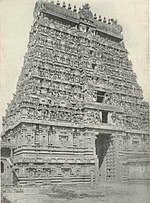
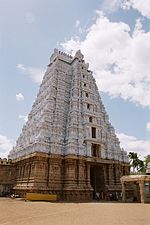
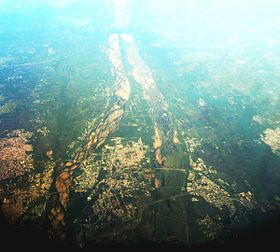

No comments:
Post a Comment